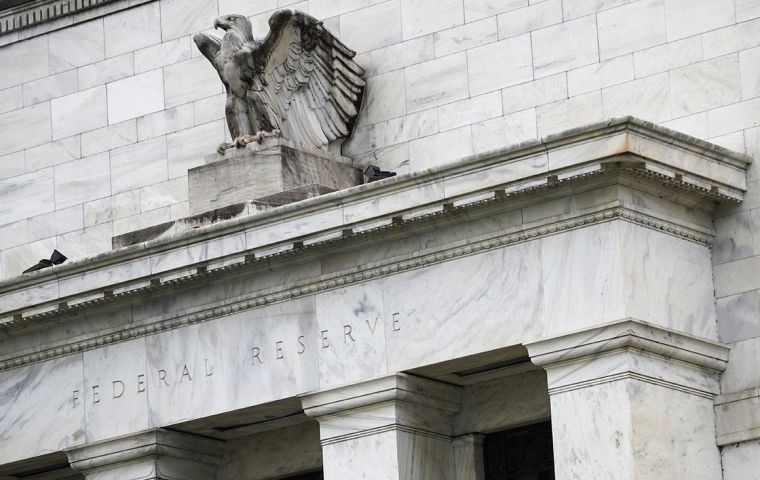MercoPress. South Atlantic News Agency
Fed raises interest rate, first time since 2018, and anticipates six/seven more increases this year
 Despite the more hawkish attitude from the Fed, market reaction was positive, S&P closed 2,24% higher, Nasdaq, 3,77%, while the Dow Jones advanced 1,55%.
Despite the more hawkish attitude from the Fed, market reaction was positive, S&P closed 2,24% higher, Nasdaq, 3,77%, while the Dow Jones advanced 1,55%. The Federal Reserve announced on Wednesday it raised its target for short-term interest rates a quarter-percentage point to 0,50% and anticipated six/seven more rate increase for the rest of 2022, as the US faces the highest inflation in four decades.
The policy-setting Federal Open Market Committee increased the federal funds rate to a range of 0.25% to 0.5%, the first rate rise since 2018. The median policymaker expects the rate to be 1.9%/2% at the end of the year, implying a total of seven rate hikes this year, and 2.8% at the end of 2023.
FOMC also raised their projections for inflation and downgraded their forecasts for growth. Inflation is expected to be 4,3% this year, compared to 2,6% projected in December and the revised forecast for GDP growth is now expected to reach only 2,8% this year, down from the 4% forecast in December.
Despite the more hawkish attitude from the Fed, reaction to the announcement from markets was positive, S&P closed 2,24% higher, Nasdaq, 3,77%, while the Dow Jones advanced 1,55%.
However analyst opinions are divided, Jim Paulsen from The Leuthold Group in Minneapolis, said investors finally feel relieved since the central bank is acting to combat inflation. “This should help soothe Main Street investors, who are centered in how to contain inflation”.
Others feel that an aggressive interest rate increase policy could lead to recession, and is to myopic as saying a year ago that inflation was “transitory”, according to Scott Ladner from Horizon Investments in North Carolina.
Joseph LaVorgna, economist chief from Americas Natixis in New York was also skeptic about the rate of increases. “I wish Jerone Powell and company the best, but I mush suspect this is a recipe for recession and loss of jobs. I can't see the Fed managing a monetary opening to contain inflationary demand”.
The FOMC release points out that economic activity and employment have continued to strengthen. Job gains have been strong in recent months, and the unemployment rate has declined substantially. Inflation remains elevated, reflecting supply and demand imbalances related to the pandemic, higher energy prices, and broader price pressures.
The invasion of Ukraine by Russia is causing tremendous human and economic hardship. The implications for the U.S. economy are highly uncertain, but in the near term the invasion and related events are likely to create additional upward pressure on inflation and weigh on economic activity.
The Committee seeks to achieve maximum employment and inflation at the rate of 2% over the longer run. With appropriate firming in the stance of monetary policy, the Committee expects inflation to return to its 2% objective and the labor market to remain strong.
In support of these goals, the Committee decided to raise the target range for the federal funds rate to 1/4 to 1/2 percent and anticipates that ongoing increases in the target range will be appropriate. In addition, the Committee expects to begin reducing its holdings of Treasury securities and agency debt and agency mortgage-backed securities at a coming meeting.
In assessing the appropriate stance of monetary policy, the Committee will continue to monitor the implications of incoming information for the economic outlook. The Committee would be prepared to adjust the stance of monetary policy as appropriate if risks emerge that could impede the attainment of the Committee's goals. The Committee's assessments will take into account a wide range of information, including readings on public health, labor market conditions, inflation pressures and inflation expectations, and financial and international developments.
Voting for the monetary policy action were Jerome H. Powell, Chair; John C. Williams, Vice Chair; Michelle W. Bowman; Lael Brainard; Esther L. George; Patrick Harker; Loretta J. Mester; and Christopher J. Waller. Voting against this action was James Bullard, who preferred at this meeting to raise the target range for the federal funds rate by 0.5 percentage point to 1/2 to 3/4 percent. Patrick Harker voted as an alternate member at this meeting.




Top Comments
Disclaimer & comment rulesCommenting for this story is now closed.
If you have a Facebook account, become a fan and comment on our Facebook Page!